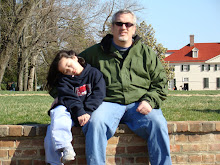Author - Price, David A.
Published 2003 - Hardcover - Alfred A. Knopf / Random House, Inc.
2005 - First Vintage Books Edition
Pages (readable) 247
OK, this is more like it. This book gives the story behind the facts and details. It probably helped that John Smith took many notes and published several books when he returned to England (That's a story in itself - He was sent back to England because basically he was not very diplomatic and did not get along with the leisure class who were also his superiors, though he very much wanted to return.) . Hence, there are a lot of details to help create the story. The whole story of how Pocahontas saved Smith is told very well.
These are some general impressions or what I learned from the book. The peace with the Native Americans was always shaky. When I read about this event in my 5th grade text book, I get the impression that when there was peace, it was absolute. Not the case. John Smith was only the President for one short year. He of course was very involved in the very first initial years of the colony before becoming president, but in total he only spent a handful of years there. His job was basically dealing with the Indians. He used a balance of intimidation and an understanding and respect of the culture to get what he wanted. Others who dealt with the Natives were far less successful. Smith came from a lower strata of society and therefore, though his skills were appreciated, he was never accepted or liked by the upper class. Partially because he didn't "know his place". He kept telling them how they were wrong in many of the decisions they were making and of course they were. That's the reason they forced him out of Jamestown. In fact at the very 1st arrival of the English, Smith was imprisoned on the ship and accused of trying to start a mutiny on the ship. It was probably not true, but the upper class gentlemen, who of course were not very pragmatic and didn't like to do manual labor,needed to get rid of him. The fact that he was able to become president was a testament to his skill as a leader.
There was nothing between Pocahontas and John Smith. She may have admired him, for his leadership qualities and his manly abilities of making war, hunting etc. But Smith saw her as a young teenage girl. He of course was grateful that she saved him and grew to have an affection and a friendship with her, but that was as far as it went. In fact, Pocahontas ended up marrying John Rolfe, a plantation owner who perhaps was not quite as manly as Smith would have been, which the book suggests she liked because she was tired of that macho attitude from the men of her own people.
After the portion of the book during Smith's era, it gets a little harder to keep track of things. There are a succession of presidents and the troubles with the Native Americans are in a continual flux. Yet there are still some interesting tales to tell. During this time there was a great massacre by the Indians. There was a presumed peace and the natives were allowed to go in and out of the colony as they pleased. This turned out to be a mistake, and the colonists were surprised. The colonists of course retaliated.
This latter time period covered by the book was a longer time period, so there are of course more presidents and events. So while reading this section, events tended to blend into one another and become less distinct. I don't think that is a failing of the writer as he was still able to maintain interest in these later stories. Besides, I think he made a decision to focus on the John Smith/Pocahontas era as he should have done. Even if he wanted to go into more detail of the latter era. there were probably less resources and less was known about that era. Remember Smith had published several books about his travails. On the other hand, it could have been simply a less interesting era.
The author uses much original sources and publishes them in the book. I think that was very successful, except some of the times these quotations were difficult to follow because the language is so different from modern English. He did paraphrase some, but I believe a little more would have been better. On the other hand, too much would have destroyed the fluency of the book.
Rating this book was difficult. When I think of fiction books, I am looking for something profound and prophetic. In a history book, that would be a little difficult to find. So I suppose my standards are a little lower for non-fiction books. I mean, a piece of fiction can touch people (if it is truly a great piece of fiction) in personal ways that can affect their very lives. I don't see a history book doing that. In a history book, I am looking for readability - a book that it is well written and enjoyable to read. I also want a piece of history to be able to draw conclusions - to synthesize the material and come up with its own ideas. This book does that to certain extent.
Subscribe to:
Post Comments (Atom)




No comments:
Post a Comment